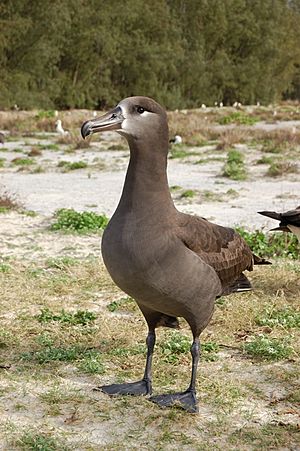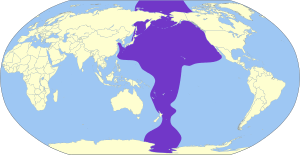Black-footed albatross facts for kids
Quick facts for kids Black-footed albatross |
|
|---|---|
 |
|
| Conservation status | |
| Scientific classification | |
| Genus: |
Phoebastria
|
| Species: |
nigripes
|
 |
|
| Synonyms | |
|
Diomedea nigripes |
|
The black-footed albatross (Phoebastria nigripes) is a large seabird that lives in the North Pacific. Most of these birds, about 97.5%, live around the Northwestern Hawaiian Islands. It is one of only three types of albatross found in the northern hemisphere. These birds build their nests on lonely tropical islands. Unlike many other albatrosses, the black-footed albatross has dark feathers.
Contents
About Albatrosses and Their Family
Black-footed albatrosses are part of a bird family called Diomedeidae. This family also includes other seabirds like shearwaters and storm petrels. All these birds belong to a larger group called Procellariiformes.
These birds have some special features. They have unique nasal passages, called naricorns, on their upper bill. Even though the albatross's nostrils are on the sides of its bill, they connect to these passages. Their bills are also special because they are made of seven to nine hard plates.
Another unique thing is that they can make a special stomach oil. This oil is stored in their stomach and is used in two ways. It can be sprayed at predators to protect themselves. It also works as a high-energy food source for their chicks and for the adult birds during their long flights.
Albatrosses also have a salt gland above their nose. This gland helps them remove extra salt from their bodies. They need this because they drink a lot of ocean water. The gland lets out a salty liquid from their nose.
The name nigripes comes from two Latin words. Niger means "black," and pes means "foot." So, nigripes means "black-footed."
What Black-footed Albatrosses Look Like
The black-footed albatross is a medium-sized member of the albatross family. Compared to most other seabirds, it is still quite large. It has almost all black feathers. Some older birds have white feathers under their tail. All adult birds have white marks around the base of their beak and under their eye. As they get older, they get more white feathers near their beak. Their beak and feet are also completely dark.
These birds are about 68 to 74 cm (27–29 in) long. Their wings can spread wide, from 190 to 220 cm (6.2–7.2 ft). They usually weigh between 2.6–4.3 kg (5.7–9.5 lb). Male albatrosses are a bit bigger than females. Males weigh about 3.4 kg (7.5 lb), while females weigh around 3 kg (6.6 lb).
Where They Live and Travel
The black-footed albatross is one of three albatross species that live in the northern part of the world. The other two are the laysan albatross and the rare short-tailed albatross. Most other albatrosses live south of the Equator.
There are at least 12 places where black-footed albatrosses are known to breed. However, about 97.5% of all these birds breed together in large groups on the lonely Northwestern Hawaiian Islands. These islands include Laysan, Midway, and the French Frigate Shoals.
Smaller groups of these birds can be found on some Japanese islands like Tori Shima and the Bonin Islands. They also live off the Mexican coast, mainly on Isla Guadalupe. They used to live on other islands like Iwo Jima and Wake Island, but they are no longer found there.
Their travel range in the sea changes with the seasons. They fly farther from their breeding islands when their chicks are older or when they are not raising chicks. They use large areas of the North Pacific, flying from Alaska to California and Japan to find food. They especially like the northeastern Pacific Ocean. They often share their breeding and feeding areas with the other two northern albatross species. However, the other two species fly even farther north into the Bering Sea. Sometimes, black-footed albatrosses have even been seen in the southern part of the world.
Albatross Behavior
Black-footed albatrosses make different sounds. When they are fighting over food, they might shriek and squeal. When they are trying to find a mate, they make sounds like bill-clapping, whistles, groans, and quacks.
Life Cycle and Reproduction
Like other albatrosses, black-footed albatrosses form strong pairs that stay together for their whole lives. After they learn to fly, young birds come back to the breeding colony when they are about three years old. They then spend two years building nests, dancing, and getting to know possible mates. This long courting period helps the birds trust each other. Raising an albatross chick takes a lot of energy, so it's important that both parents are committed. They start having chicks when they are about seven years old, and they usually lay an egg every two years.
Their nests are simple dips scraped in the sand. They lay one dull white egg with reddish-brown spots. Both parents take turns sitting on the egg to keep it warm. This is called incubating. The egg hatches after just over two months (65 days). The male often incubates more because the female leaves soon after laying the egg to get her energy back. Each parent usually takes turns incubating for about 18 days. However, a parent might wait up to 38 days for their mate to return. If something happens to one parent, the other has been known to incubate for 49 days without food or water!
After the chick hatches, its parents stay with it for 20 days to keep it warm and safe. After that, both parents leave the nest to find food for the chick. They feed the chick by bringing up food from their own stomachs. The chick puts its bill inside its parent's bill to eat. The chick is ready to fly after about 140 days.
How They Find Food
The black-footed albatross finds its food in the open ocean, far from land. This area is called the pelagic zone. They mostly eat the eggs of flying fish and squid. They also eat some crustaceans, which are like small crabs or shrimp. Sadly, they sometimes eat floating debris, including plastics.
Protecting Black-footed Albatrosses
| Breeding Location | Number of Breeding Pairs | Change |
|---|---|---|
| Midway Atoll | 24,000 | -9.6% from 1992 to 2001 |
| Laysan Island | 21,000 | -9.6% from 1992 to 2001 |
| French Frigate Shoals | 17,895 | -9.6% from 1992 to 2001 |
| Torishima | 1,218 | Unknown |
| Bonin Islands | 23 | Unknown |
| Islas Guadalupe | 337 | Unknown |
| Other offshore Mexican islands | 63 | unknown |
| Total | 64,500 | -60% over 56 years |
The IUCN says the black-footed albatross is "near threatened". This means they are close to becoming endangered. One big reason is that they often get caught by accident in longline fishing nets. It's estimated that about 4,000 albatrosses were caught each year in 1990. Other estimates suggest up to 8,000. More recent numbers show about 6,150 birds are caught each year, mostly by fishing boats from Taiwan and Japan.
These birds are also in danger from oil spills and from eating floating plastics. When they eat plastic, it fills up their stomach and leaves less room for real food, which can harm their chicks. Also, volcanic eruptions on Torishima island continue to be a threat to their nesting sites.
The black-footed albatross lives across a huge area of 37,600,000 km2 (14,500,000 sq mi) at sea. Their breeding areas cover 28 km2 (11 sq mi). There are about 129,000 adult birds. From 2005 to 2007, estimates showed 24,000 pairs breeding on Midway Atoll and 21,000 pairs on Laysan Island. Torishima has 1,218 pairs, the Bonin Islands have 23 pairs, and there are about 400 pairs on Mexican islands, with 337 on Islas Guadalupe.
To protect them, all their nesting sites in the U.S. are protected. There is also a 50 nmi (93 km) buffer zone around these islands where longline fishing is not allowed. Each year, almost 80% of the breeding population is counted. Most fishing companies now use special methods to prevent seabirds from being caught by accident.
See also
 In Spanish: Albatros de patas negras para niños
In Spanish: Albatros de patas negras para niños



